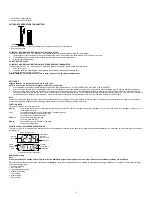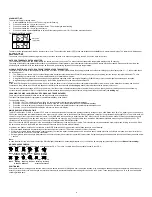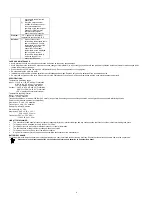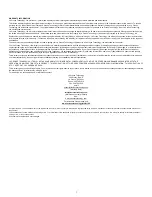
4
ALARM SETTING
To enter into the alarm setting mode:
1. Hold
the
ALM
key for 4 seconds. The hour digits start flashing.
2.
Press and release the + key to set the hour.
3.
Press and release the
ALM
key to set the minutes. The minute digits start flashing.
4.
Press and release the + key to set the minutes.
5.
Press and release again the
ALM
key to exit the Alarm setting mode or wait for 15 seconds automatic timeout.
TO DEACTIVATE THE ALARM:
The alarm will be automatically ON when the alarm time is set. To deactivate the alarm (OFF), press and release once the
ALM
key in normal mode display. The alarm icon will disappear,
the alarm is now off
SNOOZE SETTING
The snooze can only be activated during alarm time for a snooze duration of 10 minutes by pressing the SNZ key on the back of the clock
OUTDOOR TEMPERATURE TRANSMITTER:
The temperature is measured and transmitted to the atomic clock every 4 seconds. The atomic clock will update the temperature display every 20 seconds.
The range of the outdoor temperature transmitter may be affected by the temperature. At cold temperatures the transmitting distance may be decreased. Please bear this in mind when
positioning the transmitter. Also the batteries may be reduced in power during periods of extreme cold temperatures.
915MHz RECEPTION CHECK FOR OUTDOOR TEMPERATURE TRANSMITTER
The atomic clock will receive the temperature data within 4 seconds. If the temperature data is not being received 2 minutes after setting up (or the display shows “- - -”), then please check
the following points:
1.
The distance of the atomic clock or outdoor temperature transmitter should be at least 6 feet (2 meters) away from any interfering sources such as computer monitors or TV sets.
2.
Avoid placing the receiver onto or in the immediate proximity of metal window frames.
3.
Using other electrical products such as headphones or speakers operating on the same signal frequency (915MHz) may prevent correct signal transmission and reception.
4.
Neighbors using electrical devices operating on the 915MHz signal frequency can also cause interference.
Note:
When the 915 MHz signal is received correctly, do not re-open the battery cover of either the outdoor temperature transmitter or atomic clock, as the batteries may spring free from the
contacts and force a false reset. Should this happen accidentally then reset all units (see
Setting up
above) otherwise transmission problems may occur.
The maximum transmission range is 330 feet (100 meters) from the outdoor temperature transmitter to the atomic clock (in open space). However, this depends on the surrounding
environment and interference levels. If no reception is possible despite the observation of these factors, all system units have to be reset (see
Setting up
).
CHANGING THE DISPLAY MODE (DAY, SECONDS, AND TEMPERATURES)
There are four possible display modes to view the day, seconds, and temperatures.
The
indoor temperature/outdoor temperature/ month&date/weekday is the default.
To change the display:
1.
Press the + key. The display should now show the
seconds/outdoor temperature/ month&date/weekday.
2.
Press the + key a second time and the display will now show the
indoor temperature/seconds/ month&date/weekday.
3.
Press the + key third time and the display will now show the
indoor temperature/outdoor temperature/month&date/seconds
4.
Press the + key a fourth time and the display will return to the normal display.
WWVB RADIO CONTROLLED TIME
The NIST radio station, WWVB, is located in Ft. Collins, Colorado and transmits the exact time signal continuously throughout the United States at 60 kHz. The signal can be received up to
2,000 miles away through the internal antenna in the atomic clock. However, due to the nature of the Earth’s Ionosphere, reception is very limited during daylight hours. The atomic clock will
search for a signal every night when reception is best. The WWVB radio station derives its signal from the NIST atomic clock in Boulder, Colorado. A team of atomic physicists continually
measures every second of every day to an accuracy of ten billionths of a second a day. These physicists have created an international standard, measuring a second as 9,192,631,770
vibrations of a Cesium 133 atom in a vacuum. This atomic clock regulates the WWVB transmitter.
After 15 minutes the WWVB tower icon in the clock display will start flashing in the top center of the lcd. This indicates the clock has detected a radio signal and is trying to receive it. When
the time code is received, the WWVB tower becomes permanently lit and the time will be displayed.
If the tower icon flashes, but does not set the time or the WWVB tower does not appear at all, then please take note of the following:
•
Recommended distance to any interfering sources like computer monitors or TV sets is a minimum of 6 feet (2 meters).
•
Within ferro-concrete rooms (basements, superstructures), the received signal is naturally weakened. In extreme cases, please place the unit close to a window and/ or point its front or
back towards the Fort Collins, Colorado, transmitter.
•
During nighttime, the atmospheric disturbances are usually less severe and reception is possible in most cases. A single daily reception is adequate to keep the accuracy deviation below
1 second.
Note:
In case the atomic clock is not able to detect the WWVB-signal (disturbances, transmitting distance, etc.), the time can be manually set (please refer to notes on
Manual time setting
).
MOON PHASES SYMBOLS:
The Moon Phases and their corresponding dates appear in LCD 2. There are 12 visible Moon Phases that will show in the LCD 2.
New Small Large First Small Large
Moon Waxing Waxing
Quarter Waxing Waxing
Crescent Crescent Gibbous Gibbous
Full Large Small Last Large Small
Moon Waning Waning Quarter Waning Waning
Gibbous Gibbous Crescent Crescent
POSITIONING
Before permanently mounting ensure that the atomic clock is able to receive WWVB signals from the desired location. Also, extreme and sudden changes in temperature will decrease the
accuracy of the atomic clock, and changes in elevation will result with inaccurate temperatures readings for the next 12 to 24 hours. These changes will require a 12 to 24 hour wait before
obtaining reliable data.
Alarm icon
(((
•
))) (ON)

























